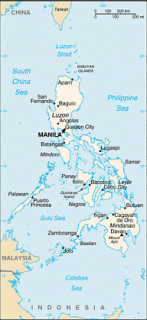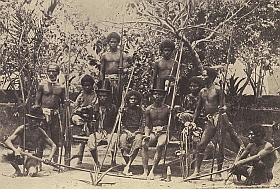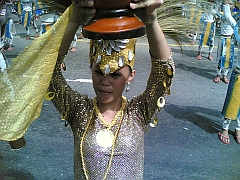
Exploring the history and experiences of mixed heritage persons and inter-racial relationships across the world

Exploring the history and experiences of mixed heritage persons and inter-racial relationships across the world
 The aboriginal peoples of many parts of Southeast Asia are known as the Negritos, simply meaning "little black person" in Spanish, and so named due to their similarity to the African Pygmies in skin colour and small stature. There are some 30 such groups of people in the Philippines alone. The Negritos were slowly displaced by Taiwanese aboriginal people thousands of years ago and over the years, the first of the several ethnic Asian ethnic groups that were to finally inhabit the islands of the archipelago. Today some 10 different ethnic groups form the native peoples of the Philippines. Historically, the indigenous population of the Philippines were referred to as Indios.
The aboriginal peoples of many parts of Southeast Asia are known as the Negritos, simply meaning "little black person" in Spanish, and so named due to their similarity to the African Pygmies in skin colour and small stature. There are some 30 such groups of people in the Philippines alone. The Negritos were slowly displaced by Taiwanese aboriginal people thousands of years ago and over the years, the first of the several ethnic Asian ethnic groups that were to finally inhabit the islands of the archipelago. Today some 10 different ethnic groups form the native peoples of the Philippines. Historically, the indigenous population of the Philippines were referred to as Indios.
 Trade with other Asian countries brought Hinduism, Buddhism, and Islam which by 1565 had reached all over the islands. The Filipino language – Tagalog – spoken by a third of Filipinos is said to contain about 25% of words from the Indian language Sanskrit. Some 5% of the population can claim some Indian ancestry and there is also genetic evidence of Arab ancestry in the population.
Trade with other Asian countries brought Hinduism, Buddhism, and Islam which by 1565 had reached all over the islands. The Filipino language – Tagalog – spoken by a third of Filipinos is said to contain about 25% of words from the Indian language Sanskrit. Some 5% of the population can claim some Indian ancestry and there is also genetic evidence of Arab ancestry in the population.
Eventually, in 1521, Portuguese explorer Ferdinand Magellan claimed the islands for Spain and it was colonised when Spanish explorer Miguel López de Legazpi arrived from Mexico in 1565 and formed the first European settlements in Cebu. The Spanish had to fight off colonial competition from both the Dutch and the British to hold onto this colony.
The Spanish followed the usual pattern and mixed with the local peoples resulting in a new elite of criollos, Spanish people born in the islands and mestizos, mixed Filipinos, who with the increased trade become quite wealthy and infiltrated the civil service to the detriment of the European Spanish. This new power resulted in higher education levels and the birth of revolutionary ideas. The Spanish also encouraged other immigrant populations to inter-marry with the locals. In particular, the Chinese immigrants, who were predominately male, were encouraged to convert to Catholicism and take up local wives resulting in a Chinese mestizo community. Later on as the population grew, people of Chinese descent including mestizos tended to intermarry resulting in a mestizo community that now accounts for some 20% of the Philippine population which means that they are the larger representation of the mestizo elite in the commercial and political spheres of the country.
In 1898, Emilio Aguinaldo, a Filipino mestizo, declared Philippine independence and the 1st Philippine Republic was established the following year but the islands had been ceded by Spain to the United States for US$20 million dollars following the Spanish-American War. The republic was short lived when the Americans established their control after the Philippine-American War in 1902.
The 2nd Philippine republic was set up after the Japanese invaded the Philippines in 1942 during the Second World War. This puppet government endured until 1945 when Japan surrendered. It is said that the Japanese were not kind rulers and one of their legacies was the pressing of young Filipino women into brothel services. It is not very clear how many children were born as a result of this policy.
 After WWII, independence followed on July 4, 1946. However, the American influence continued right up to 1992 when the last of some 21 US military bases closed down. Up to this time, it is estimated that 100,000 military personnel have been stationed in the Philippines. The result of this influence is a sub-group of mestizos commonly known as American Asian or Amerasians. After WWII, the US government passed a number of laws, namely the ‘War Brides Act’ of 1945 and the ‘Alien Fiancées and Fiancés Act’ of 1946 that allowed servicemen to bring back fiancées, wives, and children resulting in some 16,000 Filipinas entered the United States as war brides. These immigrants are more commonly known in the US as Filipino Americans. However it is estimated that there is over 52,000 Amerasian children abandoned by their fathers still in the Philippines. Pre-dominantly speaking English and spread throughout the Philippines but concentrated in the Clark area of Angeles City, these children are said to be discriminated against in the general population and more so if their mix is African American sometimes known as African-Filipinos or Afro-Filipinos. Many Amerasians are often born out of wedlock and are poor having been raised by single mothers, relatives or in institutions. The cycle of poverty continues with many prostitutes coming from this community as was reported in 1993.
After WWII, independence followed on July 4, 1946. However, the American influence continued right up to 1992 when the last of some 21 US military bases closed down. Up to this time, it is estimated that 100,000 military personnel have been stationed in the Philippines. The result of this influence is a sub-group of mestizos commonly known as American Asian or Amerasians. After WWII, the US government passed a number of laws, namely the ‘War Brides Act’ of 1945 and the ‘Alien Fiancées and Fiancés Act’ of 1946 that allowed servicemen to bring back fiancées, wives, and children resulting in some 16,000 Filipinas entered the United States as war brides. These immigrants are more commonly known in the US as Filipino Americans. However it is estimated that there is over 52,000 Amerasian children abandoned by their fathers still in the Philippines. Pre-dominantly speaking English and spread throughout the Philippines but concentrated in the Clark area of Angeles City, these children are said to be discriminated against in the general population and more so if their mix is African American sometimes known as African-Filipinos or Afro-Filipinos. Many Amerasians are often born out of wedlock and are poor having been raised by single mothers, relatives or in institutions. The cycle of poverty continues with many prostitutes coming from this community as was reported in 1993.
Much smaller that the mestizos of Chinese descent, the European/American mestizos make up just over 3% of the population though genetic studies suggest a higher level of European/American ancestry than is recognised by statistics suggesting some assimilation back into indigenous populations has occurred. Other inter-racial mixes do occur and the generic term mestizo is used in these cases.
Including the Filipino Americans, there are some 11 million Filipinos living outside the Philippines whose population numbers 94 million making it one of the most populous countries in the world. The expatriate Filipinos are stretched all over the world with a fair proportion, mainly women, working in the Middle East as domestic helpers and personal service workers. Whilst the Middle Eastern diaspora are less likely to inter-marry, it is unclear how many in other parts of the world are inter-marrying with the relevant local population.
LINKS